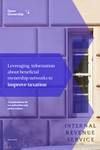Leveraging information about ownership networks to improve taxation
Help us understand how you are making use of resources from the Open Ownership website by filling out this short survey
Summary
In recent years, there has been considerable attention on how beneficial ownership (BO) information can be used to improve taxation. BO information helps understand the distribution of wealth and assets in a country, and therefore provides insights into the true tax base of an economy. With the implementation of central registers, there is an opportunity for tax authorities to systematically and proactively incorporate the use of BO information into their processes to achieve their aims more effectively.
Information about the beneficial owners of legal vehicles from central registers is essential to understanding BO networks – the networks of relationships between individuals, legal entities, and assets – but it is not the only relevant information to do so. For example, other sources such as information about shareholders and nominees partly constitute and overlap with BO information. Tax authorities may need to rely on multiple information sources to comprehensively understand the ownership and control relationships in a BO network.
This briefing explores how tax authorities can effectively use the BO information of legal vehicles from central registers and other kinds of information relevant to understanding these networks. Information about BO networks helps tax authorities through two main ways: first, by closing the tax gap through better compliance and uncovering hidden assets, revealing the sources or types of income, understanding relationships in transfers of assets, and countering criminal attacks; and second, by helping develop and deliver policy reforms to tax systems, underpinned by better insight and analysis.
Key considerations
Tax authorities should consider:
- taking a whole-of-government approach to better understanding relationships between individuals, entities, and assets;
- taking a comprehensive approach to understanding asset ownership by leveraging progress made with BO registers for legal vehicles and combining BO information for legal vehicles with information on direct interests related to entities and assets;
further developing legal and technical frameworks for accessing information within and across borders.


